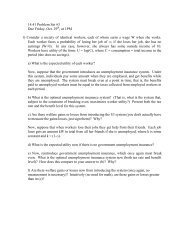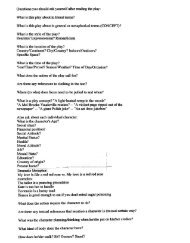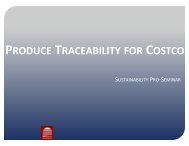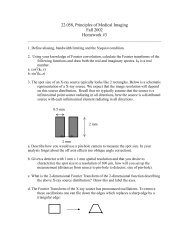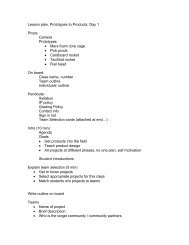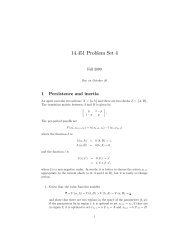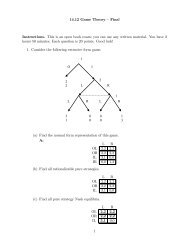Introduction to Nanoelectronics - MIT OpenCourseWare
Introduction to Nanoelectronics - MIT OpenCourseWare
Introduction to Nanoelectronics - MIT OpenCourseWare
- No tags were found...
You also want an ePaper? Increase the reach of your titles
YUMPU automatically turns print PDFs into web optimized ePapers that Google loves.
<strong>Introduction</strong> <strong>to</strong> <strong>Nanoelectronics</strong><br />
v<br />
u<br />
E<br />
E<br />
F +<br />
1 F -<br />
2<br />
Complex plane<br />
x<br />
+ -<br />
V=( 1 - 2 )/q<br />
k z<br />
3<br />
2<br />
Energy/<br />
1<br />
0<br />
-1<br />
A<br />
AB<br />
AB<br />
-2<br />
-3<br />
-/a 0 -/2a 0 0<br />
k y<br />
0<br />
/2a 0 -/2a 0 /a -/a 0 0<br />
k x<br />
/a 0<br />
/2a 0<br />
B<br />
A<br />
Marc Baldo<br />
<strong>MIT</strong> <strong>OpenCourseWare</strong> Publication May 2011<br />
© Copyright by Marc Baldo, 2011.
<strong>Introduction</strong> <strong>to</strong> <strong>Nanoelectronics</strong><br />
Preface <strong>to</strong> the <strong>OpenCourseWare</strong> publication<br />
About eight years ago, when I was just starting at <strong>MIT</strong>, I had the opportunity <strong>to</strong> attend a<br />
workshop on nanoscale devices and molecular electronics. In particular, I remember a<br />
presentation by Supriyo Datta from Purdue. He was describing electronic devices from<br />
the „bot<strong>to</strong>m up‟ – starting with quantum mechanical descriptions of a<strong>to</strong>ms and molecules,<br />
and ending up with device-scale current-voltage characteristics.<br />
Although I did not understand the details at the time, it was clear <strong>to</strong> me that this approach<br />
promised a new approach <strong>to</strong> teaching electronic devices <strong>to</strong> undergraduates. Building<br />
from a few basic concepts in quantum mechanics, and a reliance on electric potentials<br />
rather than fields, I believe that the „bot<strong>to</strong>m up‟ approach is simpler and more insightful<br />
than conventional approaches <strong>to</strong> teaching electronic transport. After five years of<br />
teaching the material, it is still remarkable <strong>to</strong> me that one can derive the current-voltage<br />
characteristics of a ballistic nanowire field effect transis<strong>to</strong>r within a 45 minute lecture.<br />
This collection of class notes is my attempt <strong>to</strong> adapt the „bot<strong>to</strong>m up‟ approach <strong>to</strong> an<br />
undergraduate electrical engineering curriculum. It can serve several roles. For most<br />
seniors, the class is intended <strong>to</strong> provide a thorough analysis of ballistic transis<strong>to</strong>rs within<br />
a broader summary of the most important device issues in computation. But for those<br />
intending <strong>to</strong> specialize in electronic devices, the class is designed as an introduction <strong>to</strong><br />
dedicated courses on quantum mechanics, solid state physics, as well as more<br />
comprehensive treatments of quantum transport such as those by Supriyo Datta himself. I<br />
can recommend both his books 1,2 , and the „nanohub‟ at Purdue University:<br />
http://nanohub.org/<strong>to</strong>pics/ElectronicsFromTheBot<strong>to</strong>mUp.<br />
The notes are designed <strong>to</strong> be self contained. In particular, this class is taught without<br />
requiring prior knowledge of quantum mechanics, although I do prefer that the students<br />
have prior knowledge of Fourier transforms.<br />
Finally, I decided <strong>to</strong> share these notes on <strong>MIT</strong>‟s <strong>OpenCourseWare</strong> with the expectation<br />
of collaboration. The „bot<strong>to</strong>m up‟ approach is still relatively novel, and these notes<br />
remain largely unpolished, with substantial opportunities for improvement! For those<br />
needing <strong>to</strong> teach a similar <strong>to</strong>pic, I hope that it provides a useful resource, and that in<br />
return you can share with me suggestions, corrections and improvements.<br />
Marc Baldo<br />
May 2010, Cambridge, MA<br />
1. Electronic Transport in Mesoscopic Systems, Supriyo Datta, Cambridge University Press, 1995<br />
2. Quantum Transport: A<strong>to</strong>m <strong>to</strong> Transis<strong>to</strong>r, Supriyo Datta, Cambridge University Press, 2005<br />
3
Acknowledgements<br />
These notes draws heavily on prior work by Supriyo Datta, „Electronic Transport in<br />
Mesoscopic Systems‟, Cambridge University Press, 1995 and „Quantum Transport: A<strong>to</strong>m<br />
<strong>to</strong> Transis<strong>to</strong>r‟, Cambridge University Press, 2005. I have also made multiple references <strong>to</strong><br />
the third edition of „Molecular Quantum Mechanics‟ by Atkins and Friedman, Oxford<br />
University Press, 1997.<br />
I would also like <strong>to</strong> thank Terry Orlando, Phil Reusswig, Priya Jadhav, Jiye Lee, and<br />
Benjie Limketkai for helping me teach the class over the years.<br />
My work is dedicated <strong>to</strong> Suzanne, Adelie, Esme, and Jonathan.<br />
4
<strong>Introduction</strong> <strong>to</strong> <strong>Nanoelectronics</strong><br />
Contents<br />
<strong>Introduction</strong> 6<br />
Part 1. The Quantum Particle 13<br />
Part 2. The Quantum Particle in a Box 52<br />
Part 3. Two Terminal Quantum Dot Devices 76<br />
Part 4. Two Terminal Quantum Wire Devices 114<br />
Part 5. Field Effect Transis<strong>to</strong>rs 139<br />
Part 6. The Electronic Structure of Materials 170<br />
Part 7. Fundamental Limits in Computation 216<br />
Part 8. References 238<br />
Appendix 1. Electron Wavepacket Propagation 239<br />
Appendix 2. The hydrogen a<strong>to</strong>m 251<br />
Appendix 3. The Born-Oppenheimer approximation 253<br />
Appendix 4. Hybrid Orbitals 254<br />
5
<strong>MIT</strong> <strong>OpenCourseWare</strong><br />
http://ocw.mit.edu<br />
6.701 / 6.719 <strong>Introduction</strong> . <strong>to</strong> <strong>Nanoelectronics</strong><br />
Spring 2010<br />
For information about citing these materials or our Terms of Use, visit: http://ocw.mit.edu/terms.



